These historic black and white photos cover the Vietnam War between 1962 and 1973. They offer us a window of what it was like being there. Warning: Some of these photos are graphic in nature. Some will make you weep.
1. Hovering U.S. Army helicopters pour machine gun fire into a tree line to cover the advance of South Vietnamese ground troops in an attack on a Viet Cong camp 18 miles north of Tay Ninh, near the Cambodian border, in March of 1965. (Horst Faas/AP)

Horst Faas/AP
2. An American officer serving with the South Vietnam forces poses with group of Montagnards in front of one of their provisionary huts in a military camp in central Vietnam on November 17, 1962. (AP)
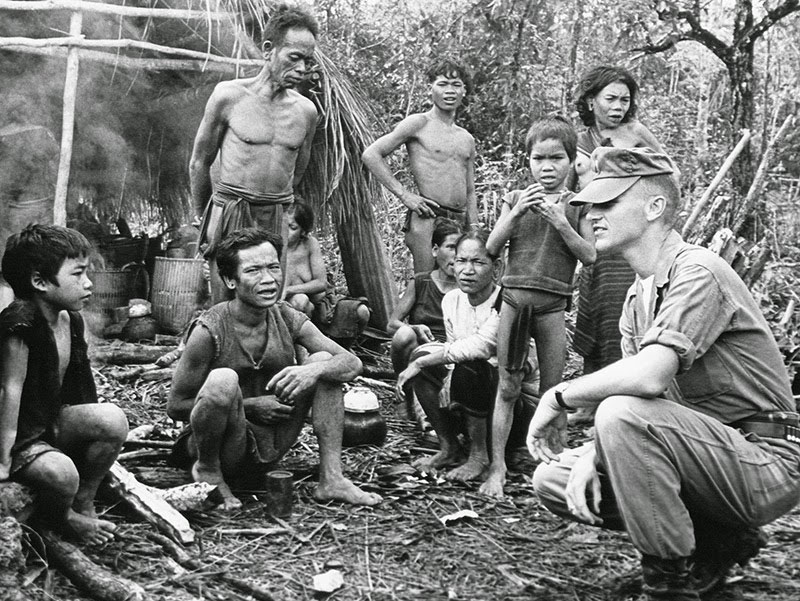
AP
3. A South Vietnamese Marine, severely wounded in a Viet Cong ambush, is comforted by a comrade in a sugar-cane field at Duc Hoa, about 12 miles from Saigon, on August 5, 1963. (Horst Faas/AP)

Horst Faas/AP
4. Napalm air strikes raise clouds into gray monsoon skies as houseboats glide down the Perfume River toward Hue in Vietnam on February 28, 1963, where a battle for control of the old Imperial City ended with a Communist defeat. Firebombs were directed against a village on the outskirts of Hue. (AP)
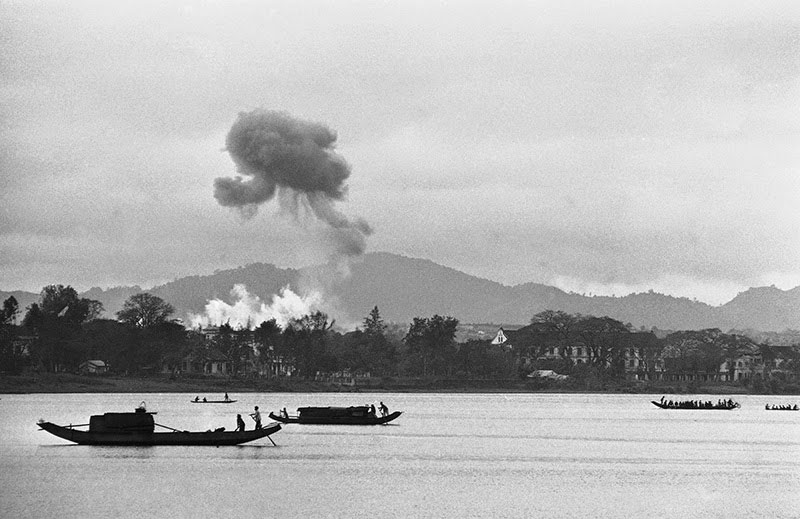
AP
5. Thich Quang Duc, a Buddhist monk, burns himself to death on a Saigon street on June 11, 1963, to protest alleged persecution of Buddhists by the South Vietnamese government. President Ngo Dình Diem, part of the Catholic minority, had adopted policies that discriminated against Buddhists and gave high favor to Catholics. (Malcolm Browne/AP)

Malcolm Browne/AP
6. Flying low over the jungle, an A-1 Skyraider drops 500-pound bombs on a Viet Cong position below as smoke rises from a previous pass at the target, on December 26, 1964. (Horst Faas/AP)
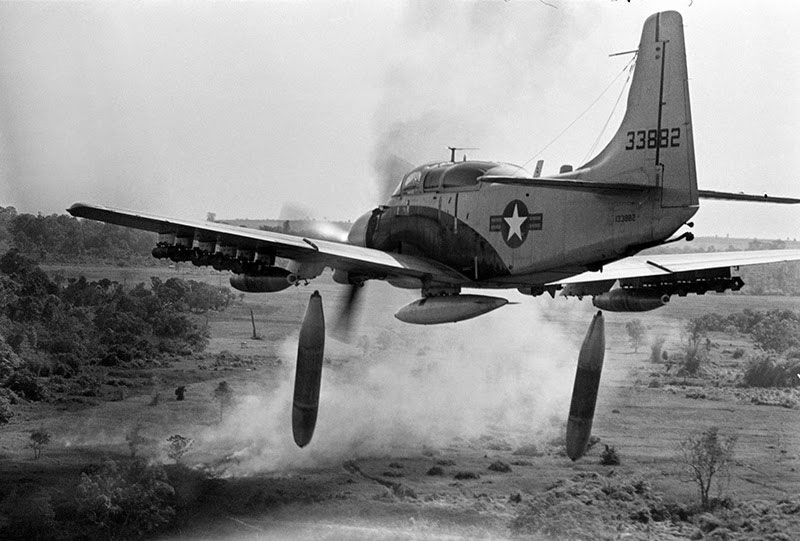
Horst Faas/AP
7. Partially covered, a dying Viet Cong guerrilla raises his hands as South Vietnamese Marines search palm groves near Long Binh in the Mekong Delta, on February 27, 1964. The guerrilla died in a foxhole following a battle between a battalion of South Vietnamese Marines and a unit of Viet Cong. (Horst Faas/AP)
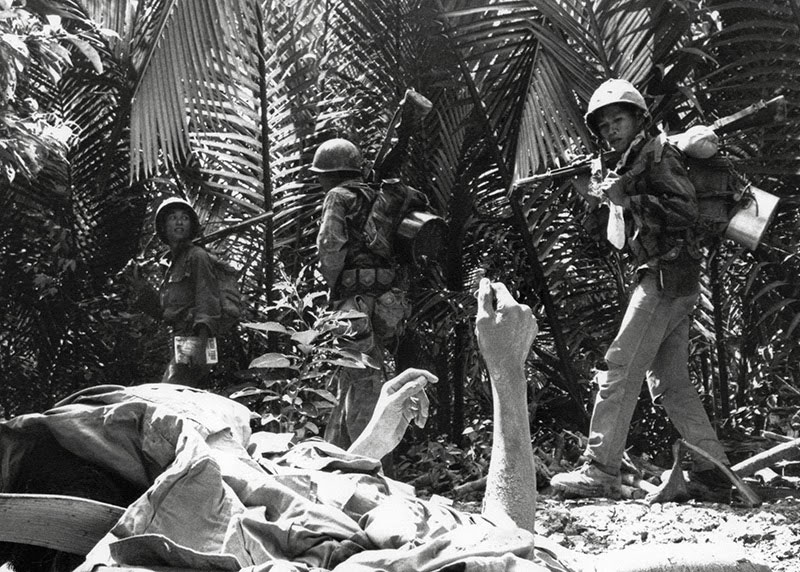
Horst Faas/AP
8. As U.S. “Eagle Flight” helicopters hover overhead, South Vietnamese troops wade through a rice paddy in Long An province during operations against Viet Cong guerrillas in the Mekong Delta, in December of 1964. The “Eagle Flight” choppers were loaded with Vietnamese airborne troops who were dropped in to support ground forces at the first sign of enemy contact. (Horst Faas/AP)

Horst Faas/AP
9. A father holds the body of his child as South Vietnamese Army Rangers look down from their armored vehicle on March 19, 1964. The child was killed as government forces pursued guerrillas into a village near the Cambodian border. (Horst Faas/AP)
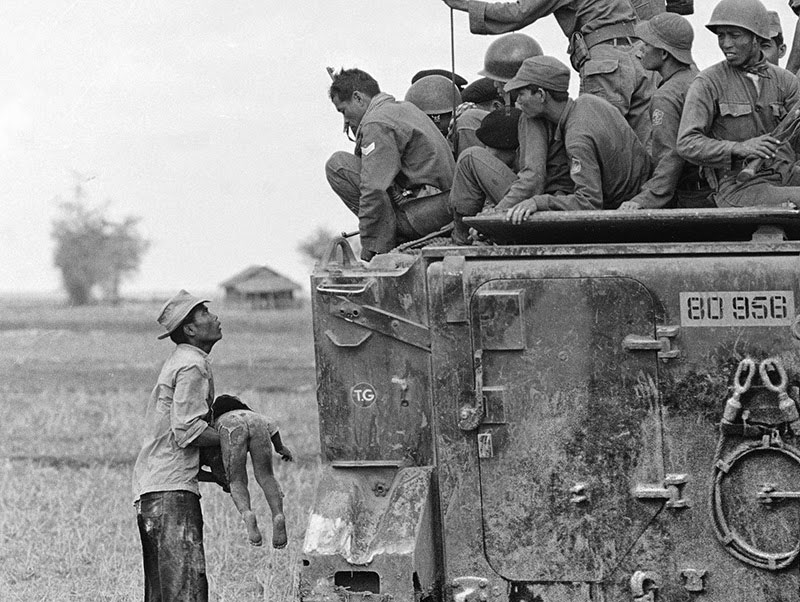
Horst Faas/AP
10. Marines wade ashore with heavy equipment at first light at Red Beach near Da Nang in Saigon on April 10, 1965. (AP)
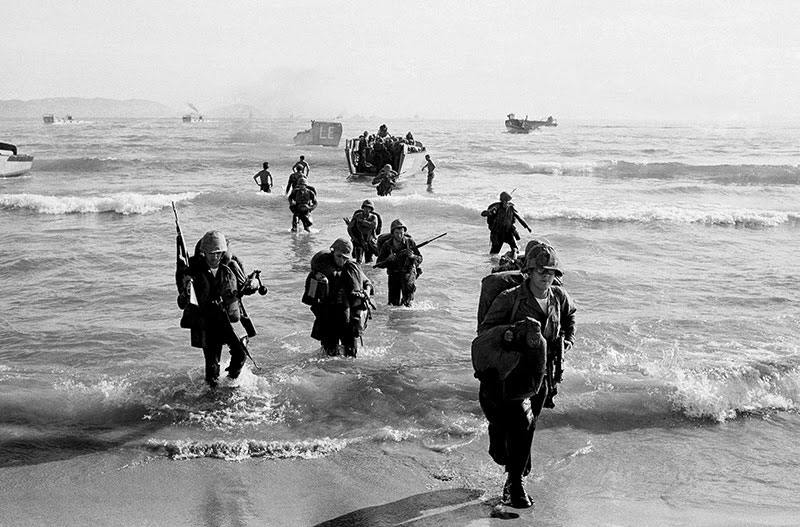
AP
11. With the persuasion of a Viet Cong-made spear pressed against his throat, a captured Viet Cong guerrilla decided to talk to interrogators, telling them of a cache of Chinese grenades on March 28, 1965. He was captured with 13 other guerrillas and 17 suspects when two Vietnamese battalions overran a Viet Cong camp about 15 miles southwest of Da Nang air force base. (Eddie Adams/AP)
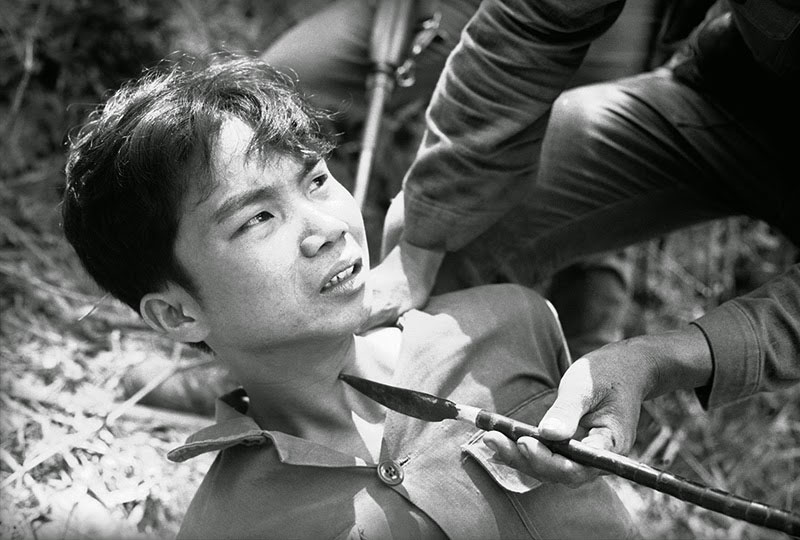
Eddie Adams/AP
12. Thousands attend a rally on the grounds of the Washington Monument in Washington on April 17, 1965, to hear Ernest Gruening, a Democratic senator from Alaska, and other speakers discuss U.S. policy in Vietnam. The rally followed picketing of the White House by students demanding an end to Vietnam fighting. (Charles Tasnadi/AP)

Charles Tasnadi/AP
13. A nurse attempts to comfort a wounded U.S. Army soldier in a ward of the 8th army hospital at Nha Trang in South Vietnam on February 7, 1965. The soldier was one of more than 100 who were wounded during Viet Cong attacks on two U.S. military compounds at Pleiku, 240 miles north of Saigon. Seven Americans were killed in the attacks. (AP)

AP
14. Flag-draped coffins of eight American Servicemen killed in attacks on U.S. military installations in South Vietnam, on February 7, are placed in transport plane at Saigon, February 9, 1965, for return flight to the United States. Funeral services were held at the Saigon Airport with U.S. Ambassador Maxwell D. Taylor and Vietnamese officials attending. (AP)
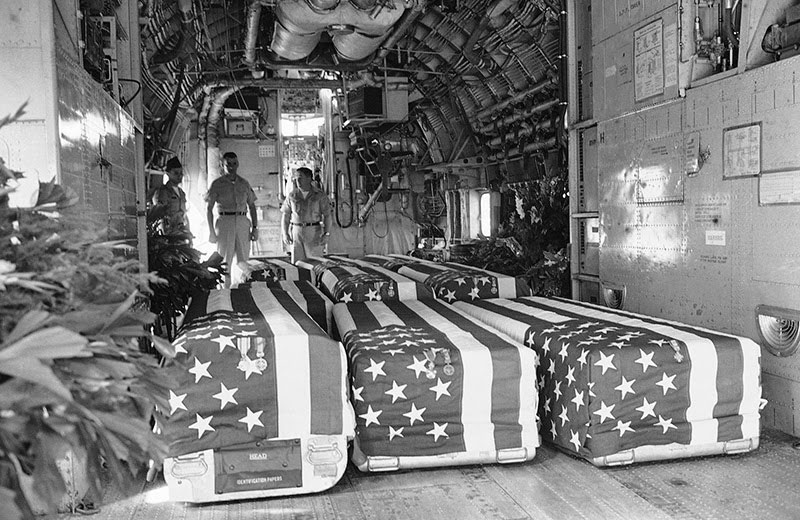
AP
15. Four “Ranch Hand” C-123 aircraft spray liquid defoliant on a suspected Viet Cong position in South Vietnam in September of 1965. The four specially equipped planes covered a 1,000-foot-wide swath in each pass over the dense vegetation. (U.S. Air Force/AP)
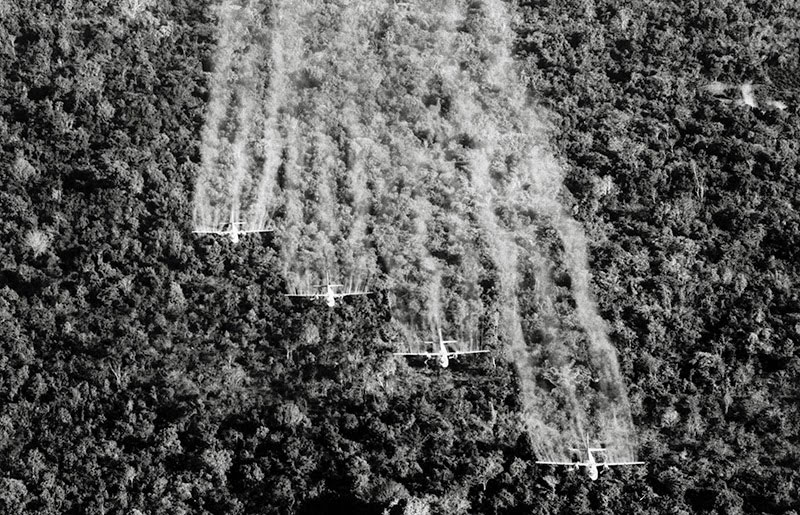
U.S. Air Force/AP
16. A Vietnamese battalion commander, Captain Thach Quyen, left, interrogates a captured Viet Cong suspect on Tan Dinh Island, Mekong Delta, in 1965. (Huynh Thanh My/AP)

Huynh Thanh My/AP
17. A strategic air command B-52 bomber with externally mounted, 750-pound bombs heads toward its target about 56 miles northwest of Saigon near Tay Ninh on November 2, 1965. (AP)
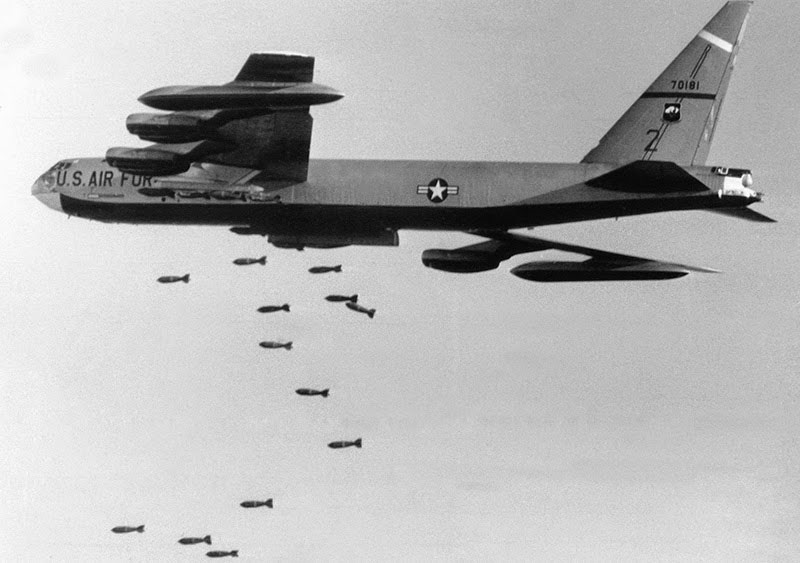
AP
18. Flares from planes light a field covered with the dead and wounded of the ambushed battalion of the U.S. 1st Cavalry Division in the Ia Drang Valley, Vietnam, on November 18, 1965, during a fierce battle that had been raging for days. Units of the division were battling to hold their lines against what was estimated to be a regiment of North Vietnamese soldiers. Bodies of the slain soldiers were carried to this clearing with their gear to await evacuation by helicopter. (Rick Merron/AP)
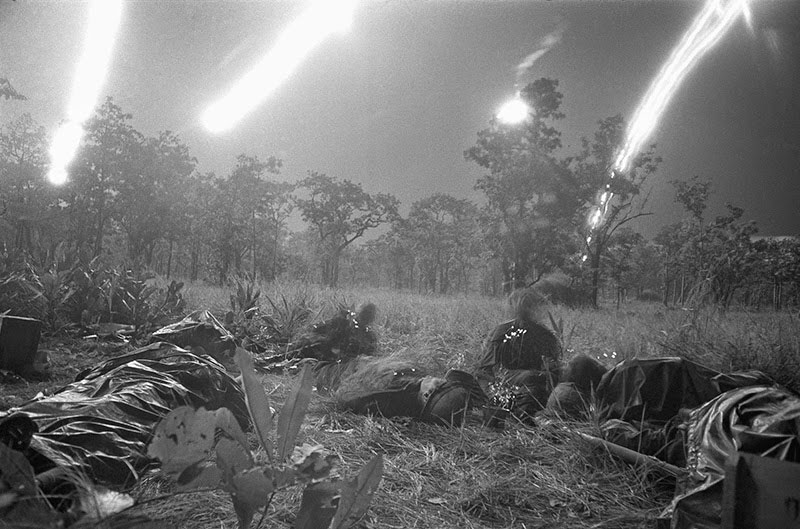
Rick Merron/AP
19. Pedestrians cross the destroyed Hue Bridge in Hue, Vietnam. (Eddie Adams/AP)
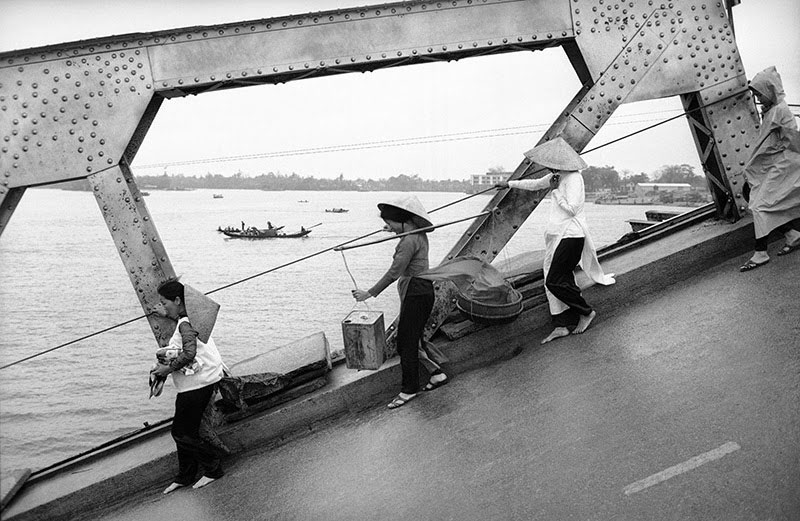
Eddie Adams/AP
20. Wounded and shocked civilian survivors of Dong Xoai crawl out of a fort bunker on June 6, 1965, where they survived murderous ground fighting and air bombardments of the previous two days. (Horst Faas/AP)
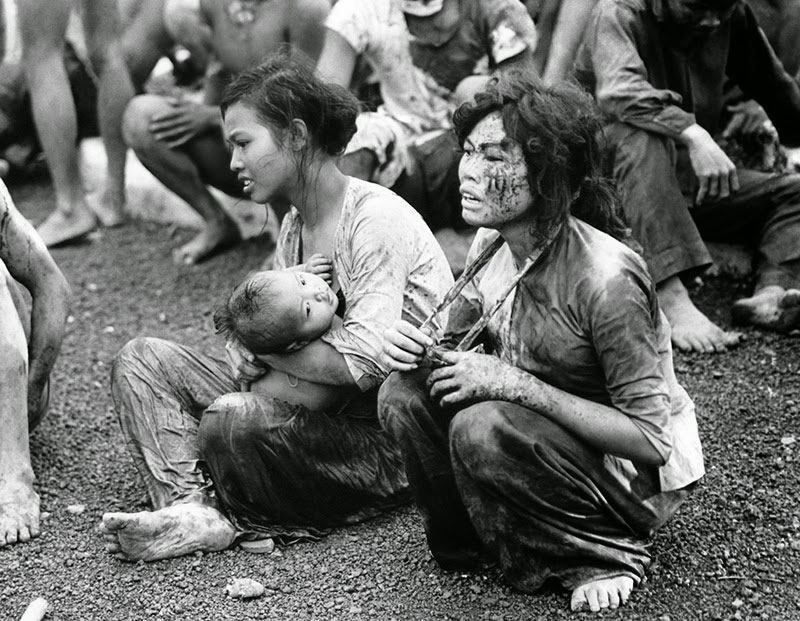
Horst Faas/AP
21. A Vietnamese girl, 23 years old, was captured by an Australian patrol 30 feet below ground at the end of a maze of tunnels some 10 miles west of the headquarters of the Australian task force (40 miles southeast of Saigon). The woman was crouched over a World War II radio set. About seven male Viet Cong took off when the Australians appeared—but the woman remained and appeared to be trying to conceal the radio set. She was taken back to the Australian headquarters where she told under sharp interrogation (which included a “waterprobe”; see her wet clothes after the interrogation) that she worked as a Viet Cong nurse in the village of Hoa Long and had been in the tunnel for 10 days. The Australians did not believe her because she seemed to lack any medical knowledge. They thought that she may have possibly been the leader of the political cell in Long Hoa. She was being led away after interrogation, clothes soaked from the “waterprobe” on October 29, 1966. (AP)
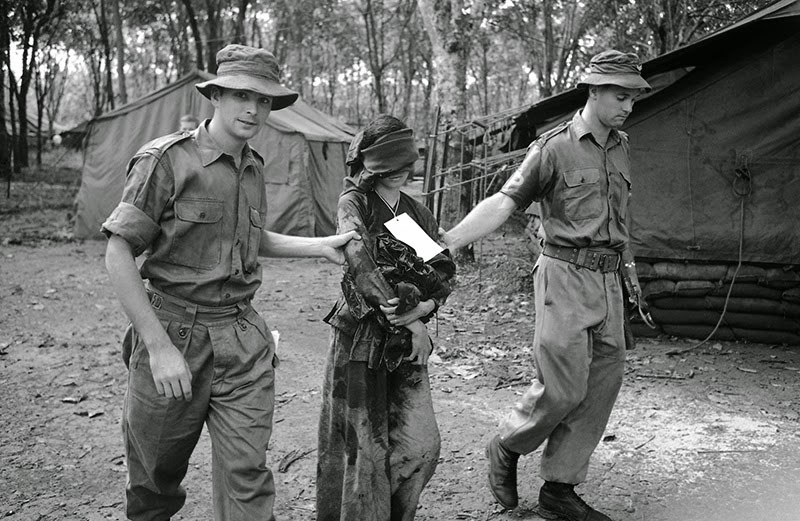
AP
22. Women and children crouch in a muddy canal as they take cover from intense Viet Cong fire at Bao Trai, about 20 miles west of Saigon, on January 1, 1966. Paratroopers, background, of the U.S. 173rd Airborne Brigade escorted the South Vietnamese civilians through a series of firefights during the U.S. assault on a Viet Cong stronghold. (Horst Faas/AP)
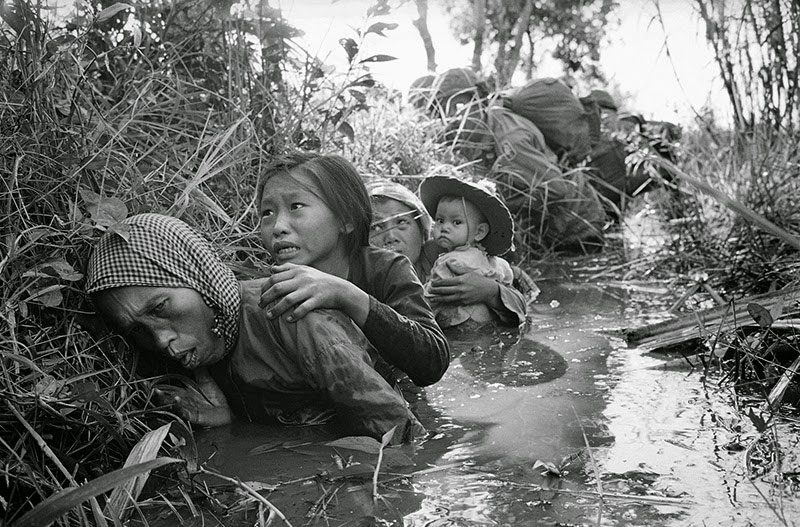
Horst Faas/AP
23. A Marine, top, wounded slightly when his face was creased by an enemy bullet, pours water into the mouth of a fellow Marine suffering from heat during Operation Hastings along the demilitarized zone between North and South Vietnam on July 21, 1966. (AP)
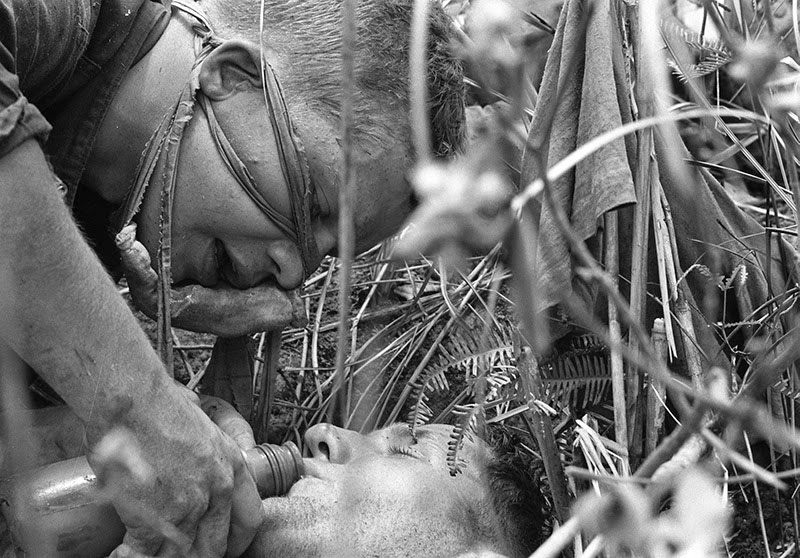
AP
24. The body of an American paratrooper killed in action in the jungle near the Cambodian border is raised up to an evacuation helicopter in War Zone C, Vietnam, in 1966. (Richard Merron, Henri Huet/AP)
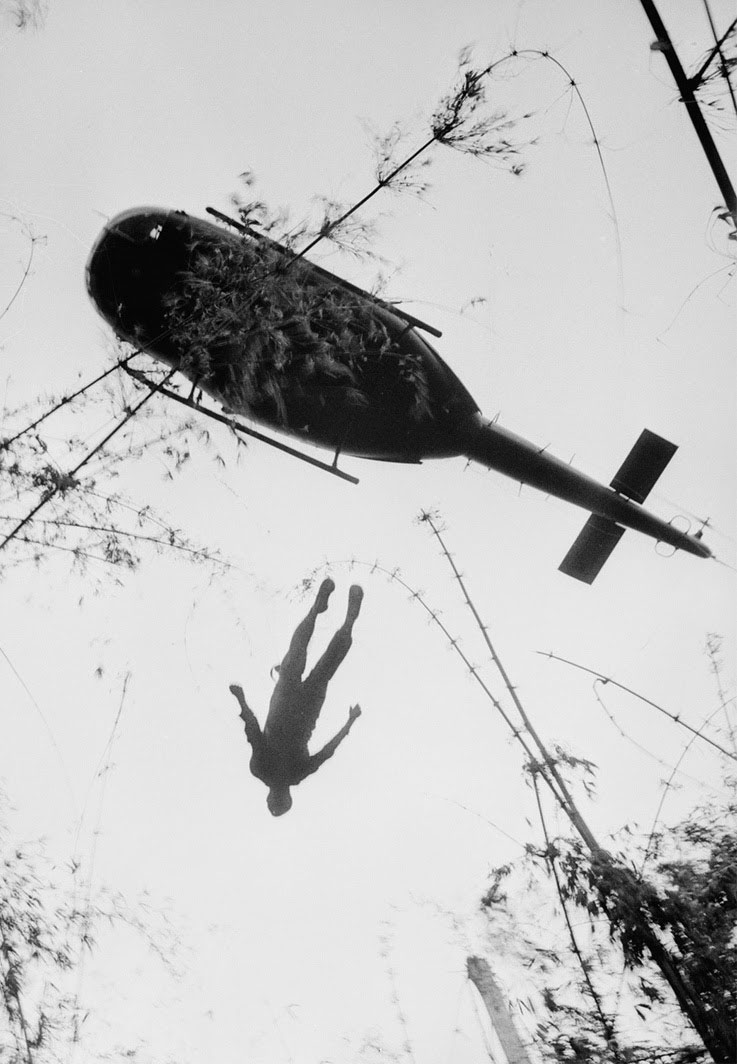
Richard Merron, Henri Huet/AP
25. A Vietnamese child clings to his bound father who was rounded up as a suspected Viet Cong guerrilla during “Operation Eagle Claw” in the Bong Son area, 280 miles northeast of Saigon on February 17, 1966. The father was taken to an interrogation camp with other suspects rounded up by the U.S. 1st air cavalry division. (Richard Merron, Henri Huet/AP)
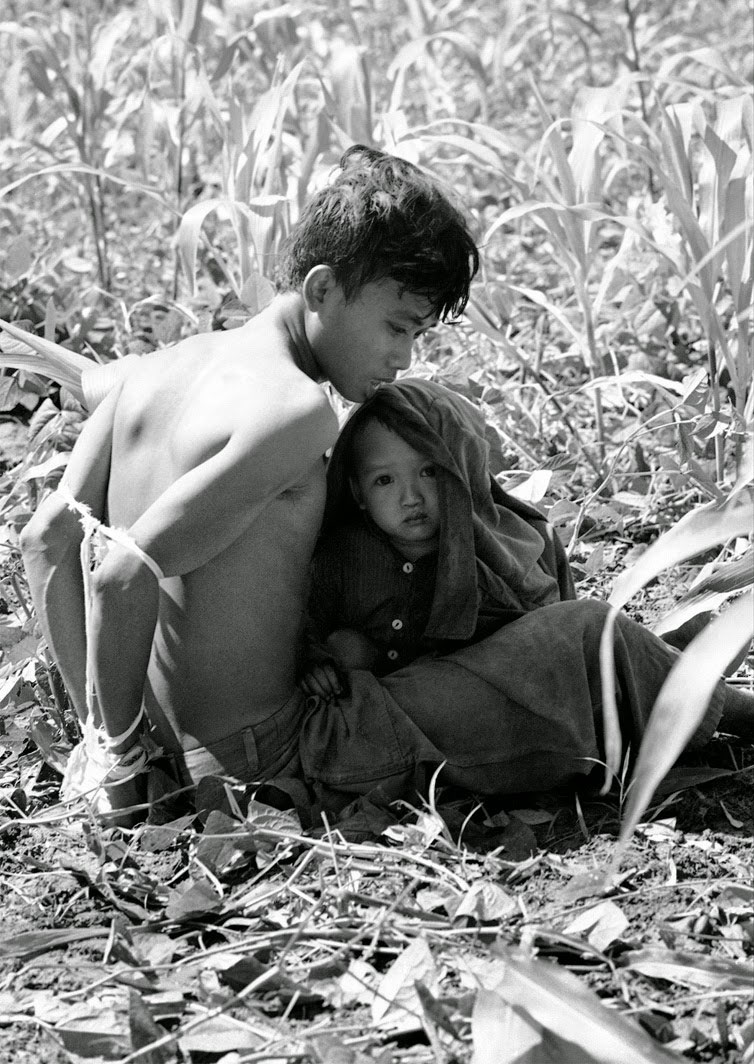
Richard Merron, Henri Huet/AP
26. A U.S. Marine CH-46 Sea Knight helicopter comes down in flames after being hit by enemy ground fire during Operation Hastings, just south of the demilitarized zone between North and South Vietnam, on July 15, 1966. The helicopter crashed and exploded on a hill, killing one crewman and 12 Marines. Three crewmen escaped with serious burns. (Horst Faas/AP)
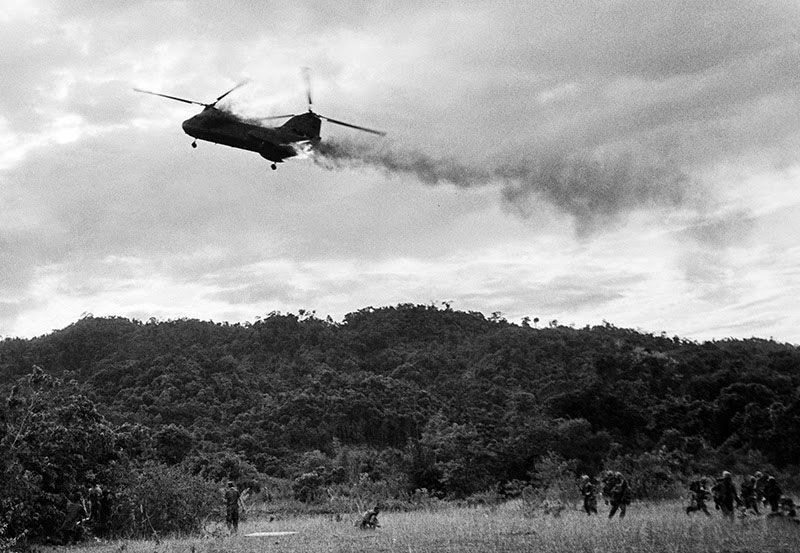
Horst Faas/AP
27. A trooper of the U.S. 1st cavalry division aims a flamethrower at the mouth of cave in An Lao Valley in South Vietnam, on April 14, 1967, after the Viet Cong group hiding in it were warned to emerge. (AP)

AP
28. Sergeant Ronald Payne, 21, of Atlanta, Georgia, emerges from a Viet Cong tunnel holding his silencer-equipped revolver with which he fired at guerrillas fleeing ahead of him underground. Payne and others of the 196th light infantry brigade probed the massive tunnel in Hobo Woods, South Vietnam, on January 21, 1967, and found detailed maps and plans of the enemy. The infantrymen who explored the complex are known as “Tunnel Rats.” They were called out of the tunnels on January 21, and nauseating gas was pumped in. (AP)
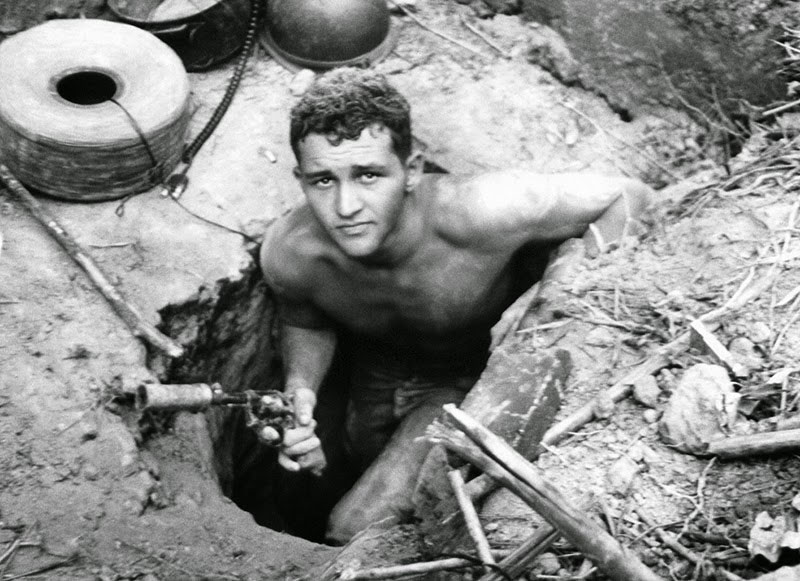
AP
29. Military police, reinforced by Army troops, throw back anti-war demonstrators as they tried to storm a mall entrance doorway at the Pentagon in Washington, D.C., on October 21, 1967. (AP)

AP
30. U.S. Navy Douglas A-4E Skyhawks from Attack Squadrons VA-163 Saints and VA-164 Ghost Riders attack the Phuong Dinh railroad bypass bridge, 10 kilometers north of Thanh Hoe, North Vietnam, on September 10, 1967. Note the attacking Skyhawk in the lower right and one directly left of the explosions on the bridge. (Lt. Cdr. Jerry Breast/U.S. Navy)
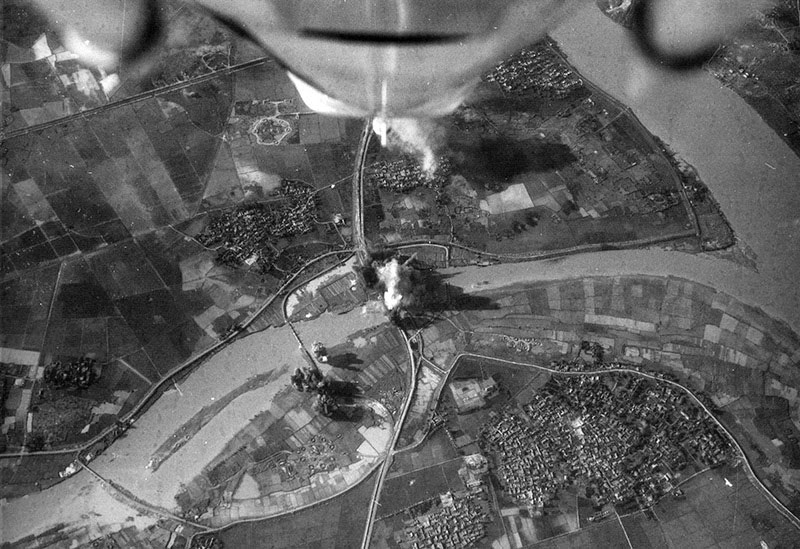
Lt. Cdr. Jerry Breast/U.S. Navy
31. U.S. air policemen take cover and leave their jeep as they come under sniper fire near Da Nang Airbase in Vietnam on January 30, 1968, after it was hit by a rocket barrage. Flares light up the Da Nang area to make it easier to spot infiltrating guerrillas. (AP)

AP
32. Battle of Saigon, First Offensive, on February 10, 1968. (Eddie Adams/AP)
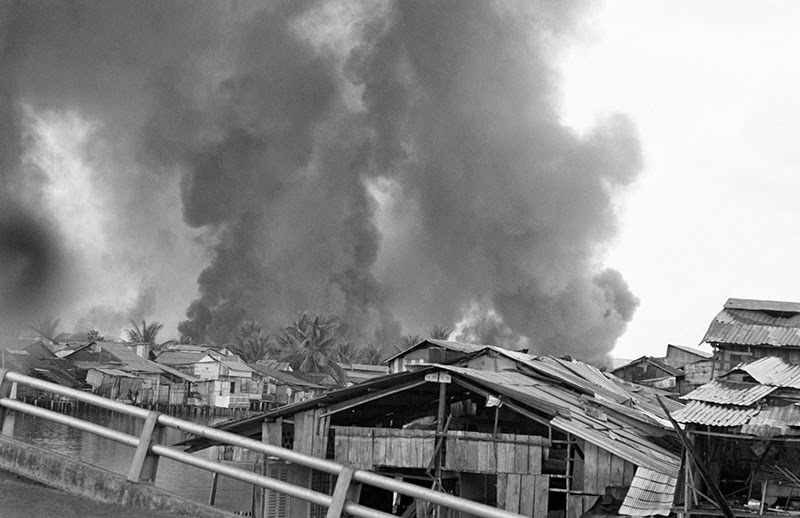
Eddie Adams/AP
33. U.S. Marines and Vietnamese troops move through the grounds of the Imperial Palace in the old citadel area of Hue, Vietnam, on February 26, 1968, after seizing it from Communist hands. The heavy damage was the result of the artillery, air, and mortar pounding the area received for 25 days while the Viet Cong/NVA held the area. (Eddie Adams/AP)
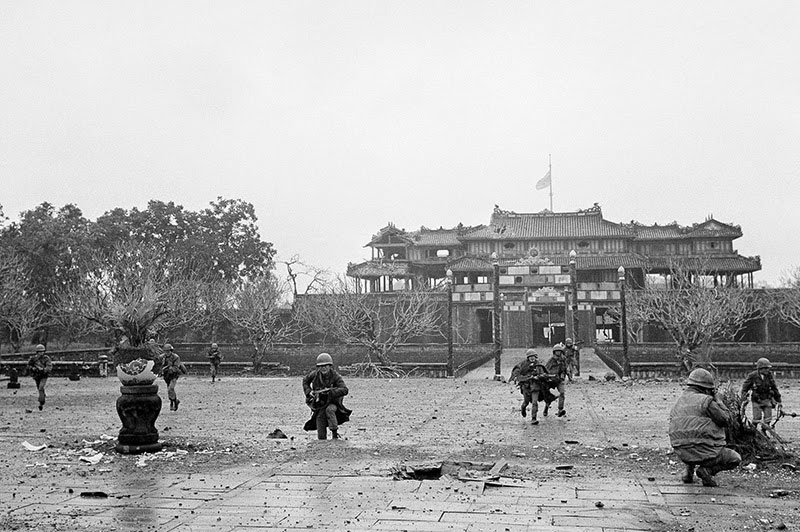
Eddie Adams/AP
34. South Vietnamese combat police advance toward a burning building in northeastern Saigon on February 19, 1968, as they battle Viet Cong forces who had occupied several city blocks in the area. (AP)
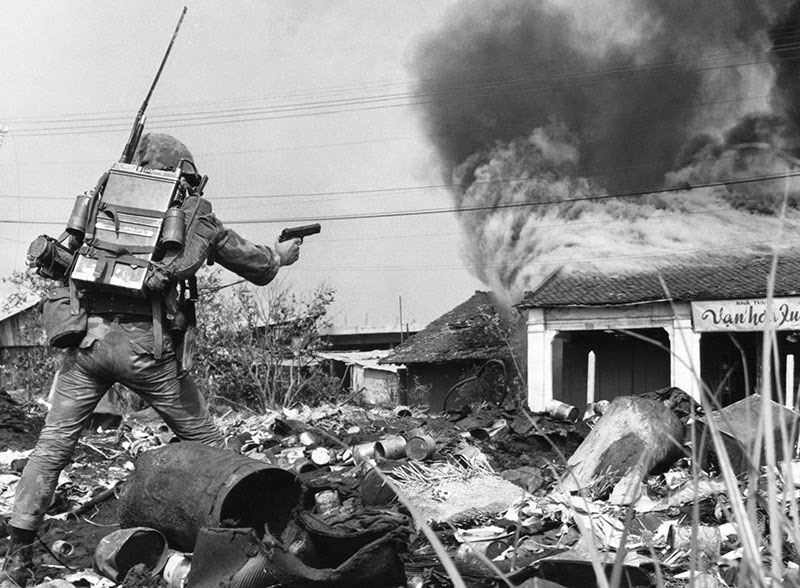
AP
35. The South Vietnamese General Nguyen Ngoc Loan, chief of the national police, fires his pistol into the head of suspected Viet Cong officer Nguyen Van Lem (also known as Bay Lop) on a Saigon street on February 1, 1968, early in the Tet Offensive. Lem was suspected of commanding a death squad which had targeted South Vietnamese police officers that day. The fame of this photo led to a life of infamy for Nguyen Ngoc Loan, who quietly moved to the United States in 1975, opening a pizza shop in Virginia. (Eddie Adams/AP)
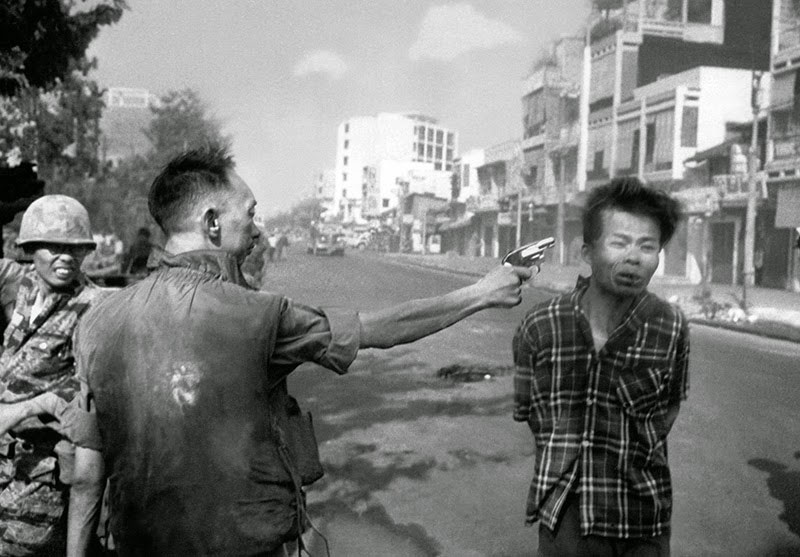
Eddie Adams/AP
36. Police struggle with anti-Vietnam War demonstrators outside the Embassy of the United States in Grosvenor Square, London, on March 17, 1968. (AP)
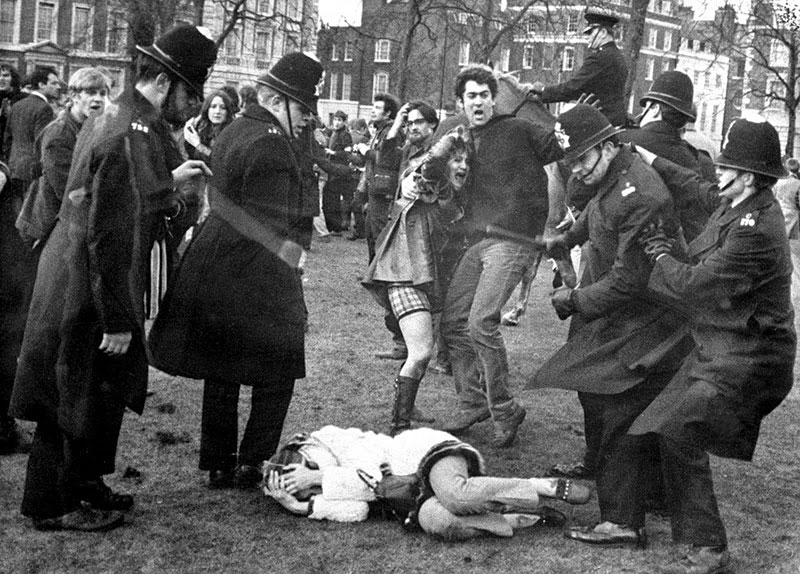
AP
37. Marine Lance Corporal Roland Ball of Tacoma, Washington, wearing his flak vest, starts the day off with a shave in a trench at the Khe Sanh Base in Vietnam on March 5, 1968, which was surrounded by North Vietnamese regulars. Ball uses a helmet as a sink and a rear-view mirror taken from a military vehicle. (Eddie Adams/AP)
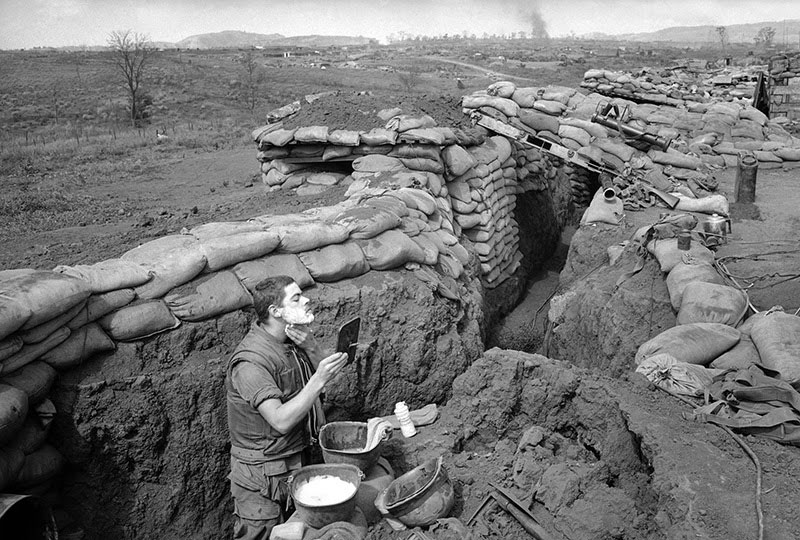
Eddie Adams/AP
38. As fellow troopers aid wounded comrades, the first sergeant of A Company, 101st Airborne Division, guides a medevac helicopter through the jungle foliage to pick up casualties suffered during a five-day patrol near Hue, in April of 1968. (Art Greenspon/AP)
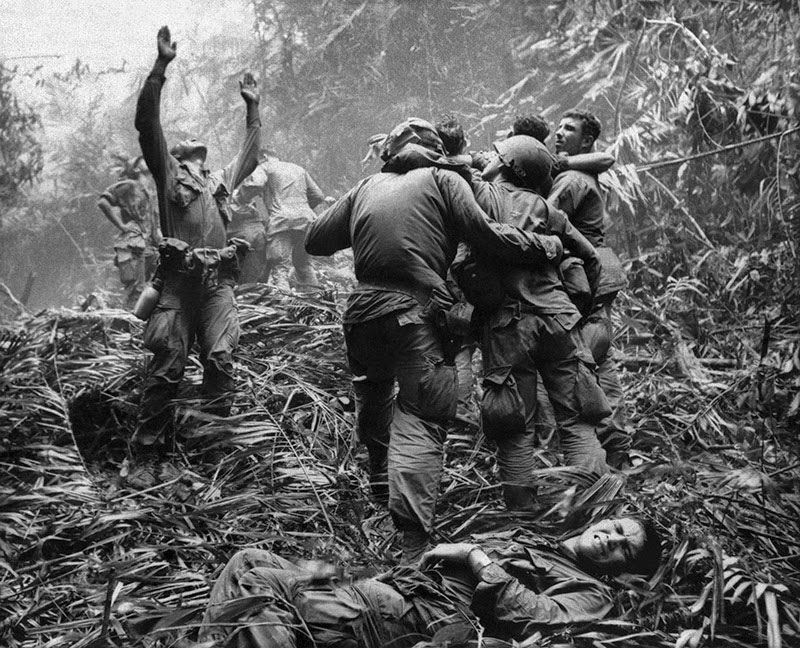
Art Greenspon/AP
39. Smoke rises from the southwestern part of Saigon on May 7, 1968, as residents stream across the bridge leaving into the capital to escape heavy fighting between the Viet Cong and South Vietnamese soldiers. (MIN/AP)

MIN/AP
40. Flying 100 feet above the jungle hills west of Hue, five bulky C-123 “providers” cut loose a spray of chemical defoliant on August 14, 1968. The planes are flown by U.S. air force crews who have nicknamed themselves the “ranch hands.” The aircraft are specially equipped with huge 1,000-gallon tanks holding 11,000 pounds of herbicide. U.S. planes dropped millions gallons of chemical defoliant on Vietnam over the course of the war. (Robert Ohman/AP)
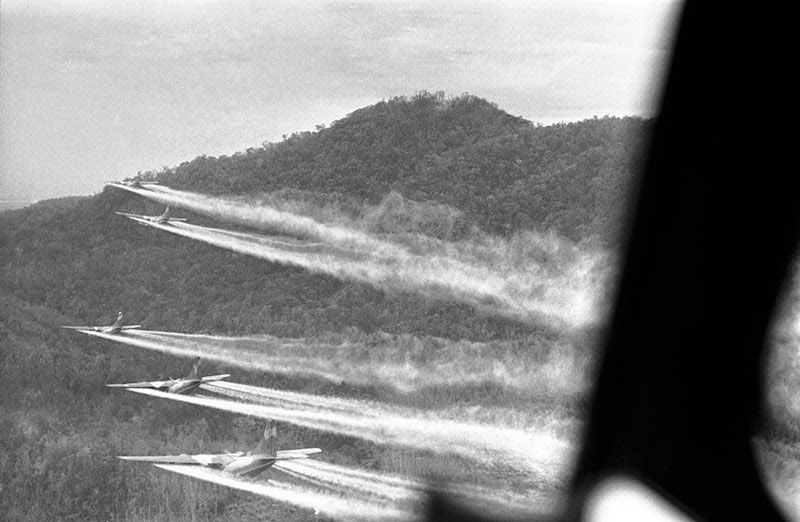
Robert Ohman/AP
41. Marines prepare their 105-mm Howitzers for action at the end of a day in which this dense jungle area west of Hue was chopped down and molded into a fire-support base for a sweep of the area on February 18, 1969. (Dang Van Phuoc/AP)
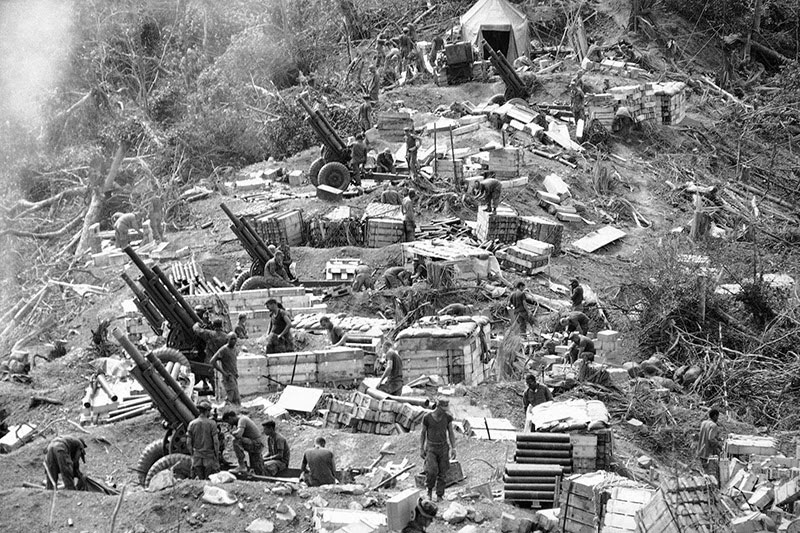
Dang Van Phuoc/AP
42. A Cobra helicopter gunship pulls out of a rocket and strafing attack on a Viet Cong position near Cao Lanh in the Mekong Delta on January 22, 1969. Large craters caused by air and artillery strikes brought in on the area can be seen near the white explosion. (McInerney/AP)

McInerney/AP
43. FBI agents carry Vietnam War draft resister Robert Whittington Eaton, 25, from a dwelling in Philadelphia on April 17, 1969, where Eaton had chained himself to 13 young men and women. The agent leading the way pushed one of the group who tried to block path to the sidewalk. At least six young persons were taken away with Easton. (Warren M. Winterbottom/AP)

Warren M. Winterbottom/AP
44. A trooper of the 101st Airborne Division attempts to save the life of a buddy at Dong Ap Bia Mountain, near South Vietnam’s A Shau Valley on May 19, 1969. The man was seriously wounded in the last of repeated attempts by U.S. forces to capture enemy positions there. (Van Es/AP)
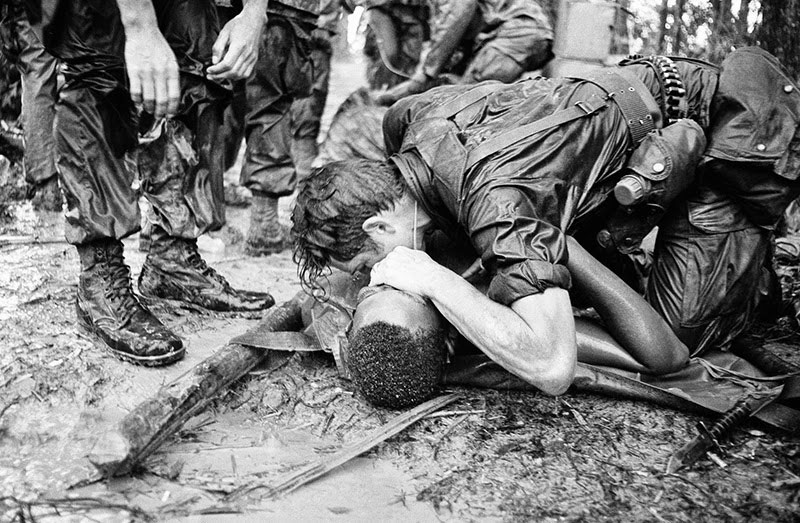
Van Es/AP
45. A GI gets a closeup photo as President Nixon meets with troops of the 1st Infantry Division at Di An, 12 miles northeast of Saigon, on his eighth visit to South Vietnam and his first as president, on July 30, 1969. (Bob Daugherty/AP)
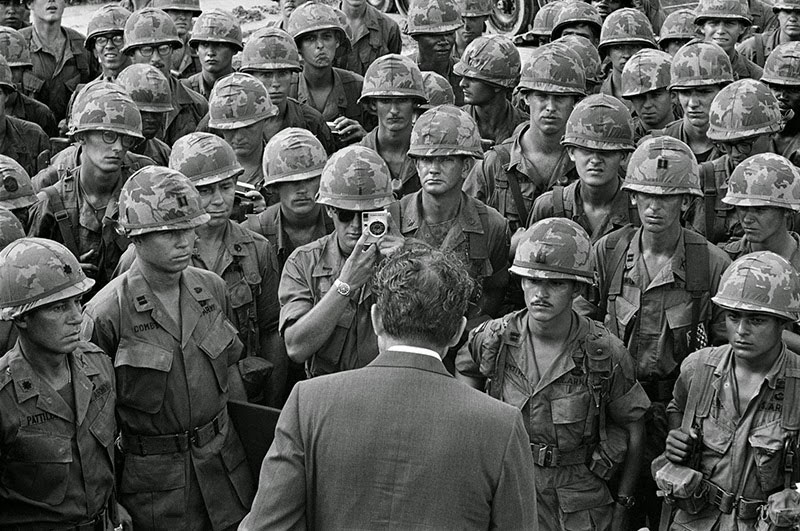
Bob Daugherty/AP
46. Marine Lance Corporal David L. Cruz tunes into the latest news on the Apollo moon shot on a helmet-mounted transistor radio while standing guard at Da Nang’s Marble Mountain, on July 17, 1969. In background is a tall Buddhist figure found in many limestone caves of the mountain. (Ghislain Bellorget/AP)
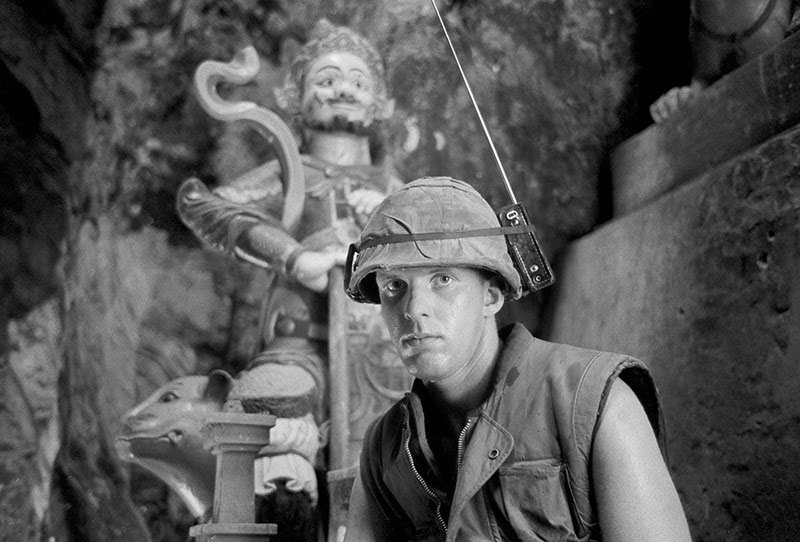
Ghislain Bellorget/AP
47. Three shirtless U.S. soldiers advance through the Mimot rubber plantation in the Fishhook region of Cambodia, on May 4, 1970, taking aim at a fleeing suspect. The rubber plantation, one of the largest in Indochina, had been in operation until just a few days earlier. (Henri Huet/AP)
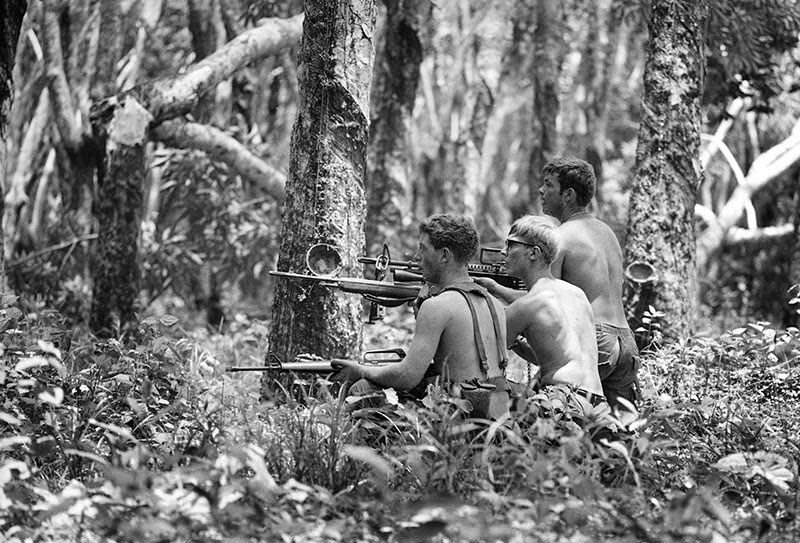
Henri Huet/AP
48. Vietnamese and Cambodian refugees crowd a U.S. helicopter which evacuated them from immediate combat zone of the U.S.-Vietnamese incursion into Cambodia on May 5, 1970. They were taken to a refugee reception center at the Katum Special Forces camp in South Vietnam, six miles from the Cambodian border. (Ryan/AP)
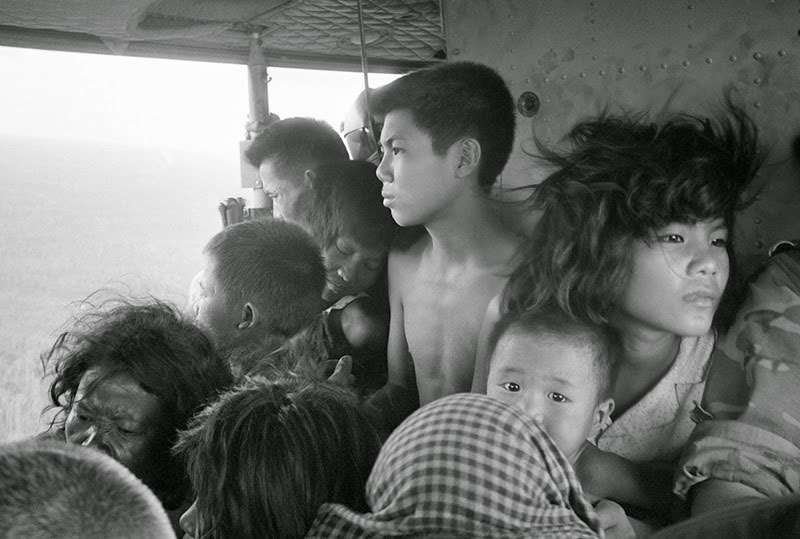
Ryan/AP
49. The Ohio National Guard moves in on rioting students at Kent State University in Kent, Ohio, on May 4, 1970. Four persons were killed and eleven wounded when National Guardsmen opened fire. (AP)
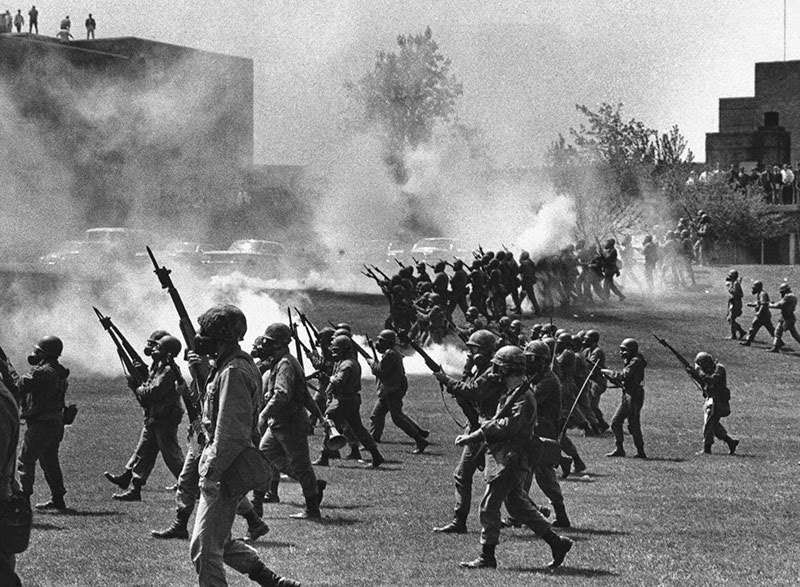
AP
50. Fourteen-year-old Mary Ann Vecchio screams over the body of 20-year-old Kent State student Jeffrey Miller after he was shot by the Ohio National Guard during a protest against the U.S. invasion of Cambodia during the Vietnam War on May 4, 1970. (John Paul Filo/Library of Congress)

John Paul Filo/Library of Congress
51. South Vietnamese troopers test fire flame throwers mounted atop APCs prior to moving out on operation west of Krek, Cambodia, on November 28, 1971. (Jacques Tonnaire/AP)

Jacques Tonnaire/AP
52. Bombs with a mixture of napalm and white phosphorus jelly dropped by Vietnamese AF Skyraider bombers explode across Route 1, amid homes and in front of the Cao Dai Temple in the outskirts of Trang Bang, on June 8, 1972. In the foreground are Vietnamese soldiers and news and cameramen from various international news organizations who watch the scene. (Nick Ut/AP)
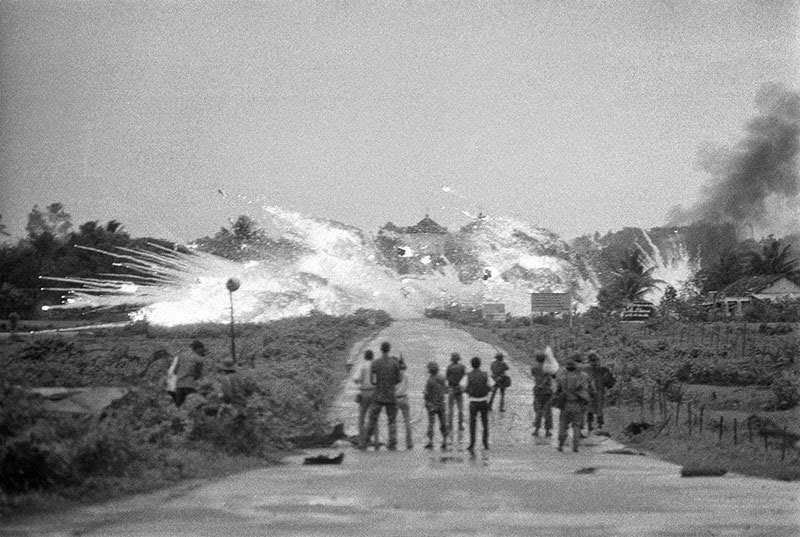
Nick Ut/AP
53. A beheaded statue of an American soldier stands next to a bombed-out theater near the district town of Cu Chi, northwest of Saigon, on December 13, 1972. The statue was placed by troops of the U.S. 25th Infantry Division before they were withdrawn from Vietnam two years earlier. Its head was lost in the explosion that destroyed the theater in background. (Harvey/AP)
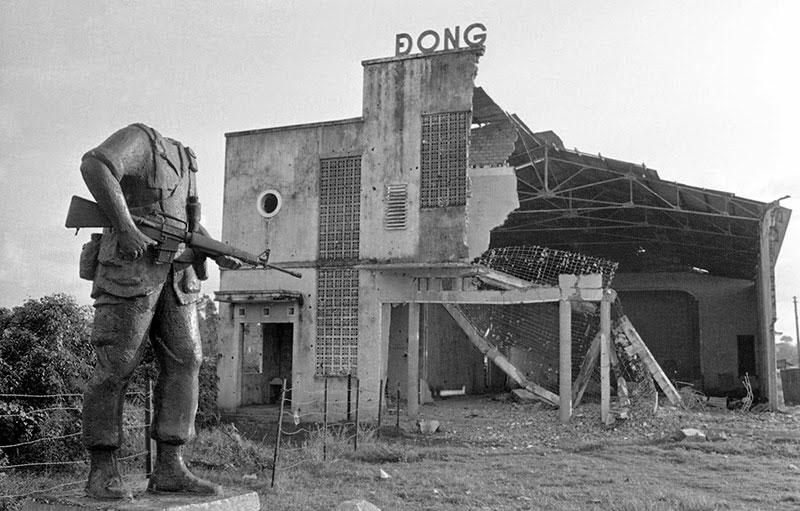
Harvey/AP
54. A South Vietnamese widow cries as a bell at a Saigon Buddhist pagoda tolls the ceasefire at 8 a.m., on Sunday, January 28, 1973, Saigon time. The United States had begun drastically reducing forces in the country, and, following the Paris Peace Accords of 1973, the last remaining American troops withdrew in March of 1973. (Neal Ulevich/AP)
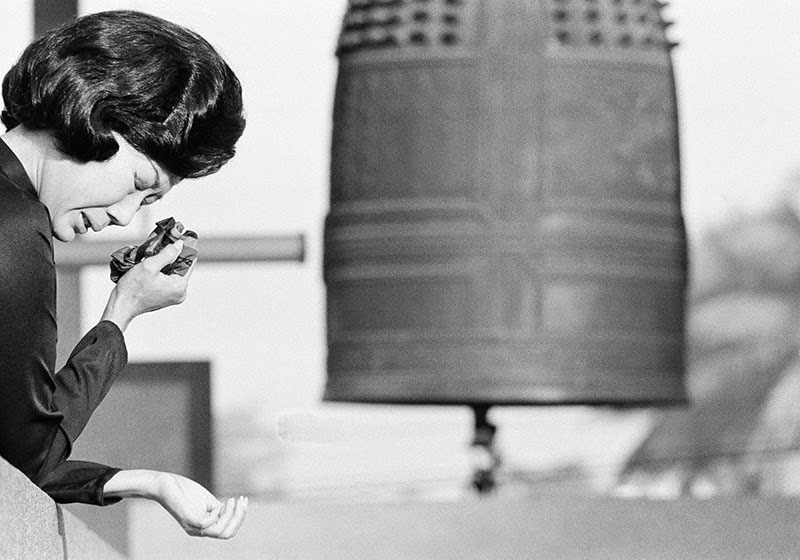
Neal Ulevich/AP
55. A bon voyage banner stretches overhead in Da Nang, South Vietnam, as soldiers march down a street following a farewell ceremony for some of the last U.S. troops in the country’s northern military region, on March 26, 1973. (AP)
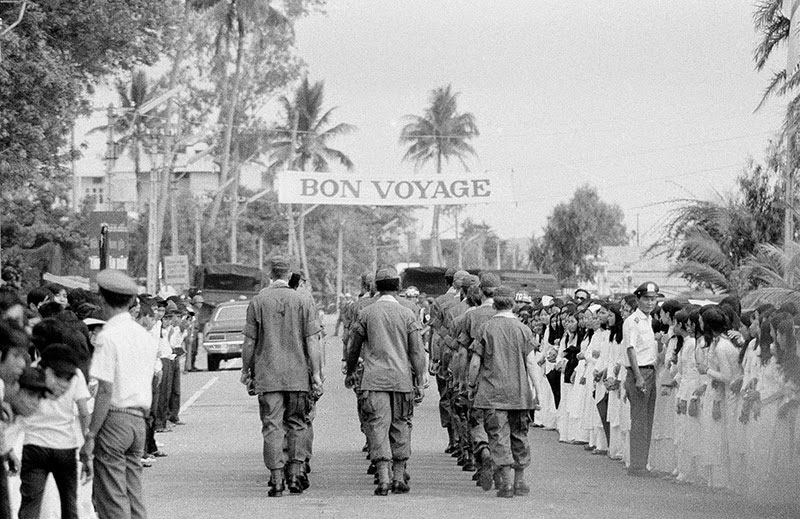
AP

